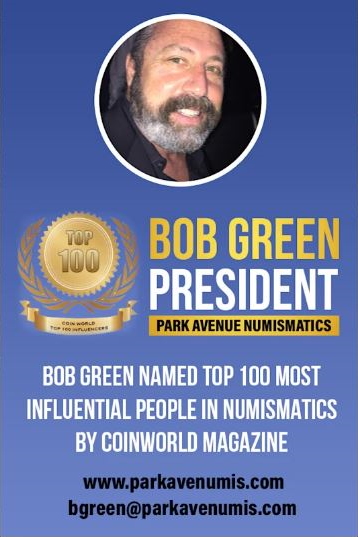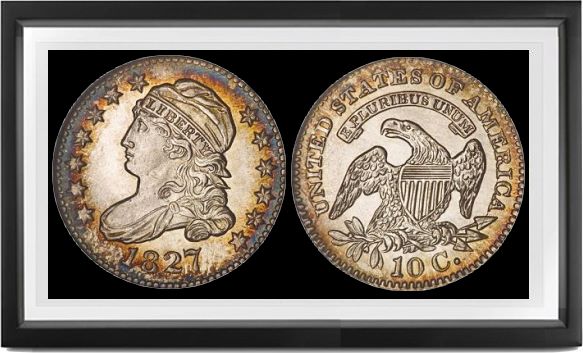Park Avenue Numismatics
5084 Biscayne Blvd, Suite 105
Miami, FL 33137
Toll Free: 888-419-7136
Secure Private Ordering
We use the latest online security processing,
so your order is safe & private.
We DO NOT disclose any customer
information to ANY third party company.
Our customer privacy is our priority.
Over 30 Years Experience
Park Avenue has over 30 years
experience buying and selling
Rare Coin and Precious Metals.
We have the knowledge and
ability to provide our customers
with the best products and services.




CAPPED BUST DIMES, LARGE SIZE (1809-1828)

THE NEW REICH DESIGN, whatever its aesthetic demerits, represented a distinct mechanical advance over both previous types of designs. Heretofore, only the draped bust and eagle had been imparted to working dies by hubbing. On the previous Heraldic design (1798-1807), to the basic central elements had to be added by hand some 63 elements: date, inscriptions, stars on both sides, berries. In addition, arrows and some other details had to be strengthened by hand. With the new design—adapted by Reich from the devices he had first used on the half dollars of 1807—the number of elements which must be entered by hand dropped to 42, with far fewer details needing to be strengthened in each working die. This meant that each die took less time to complete (note that every numeral or letter that must be hand entered had to be hammered and rehammered into the die blank until it made a deep enough indention), with less stress hardening and consequent brittleness, and a consequent improvement in die life. The ultimate object was to allow for a great expansion in quantities of coinage.
This expansion did not materialize until 1827 and not much even then. Local banks seldom ordered dimes to be made from their bullion, as worn Spanish or Mexican one-real pieces were preferred in trade. The small quantities that did reach circulation stayed there; strictly Uncirculated dimes of this design dated before 1827 are very rare.
Mintage figures given for 1809 should be increased by 6,355 to include that quantity struck in 1810 from 1809 dies. All 1811 coins have the date 1811 over 1809, from an unused 1809 die, testifying to unexpectedly low bank demand for the denomination; on later impressions from shattered dies, the figures 09 with 11 are very hard to see. Despite contrary Guidebook listings, the Small Date variety of 1814 is much rarer than the Large Date of the year, considerably rarer even than 1811, and very difficult to locate in Mint State. This year, 1814, is also marked by one other rarity, showing STATESOFAMERICA as one word. The same die was reused in 1820; put aside as an obvious blunder, the die was later included in one of the lots of scrap metal sold by the Mint, recovered by private parties, and eventually bought by Robert Bashlow (the promoter of the restrikes of the Confederate cent, 1961), who had some 536 impressions struck from it in Scotland, in platinum, gold, silver, nickel, copper and other metals. Some of these were uniface, others had a fantasy reverse reading GOD PRESERVE PHILADELPHIA AND THE LORDS PROPRIETORS. The die and all impressions were seized by Treasury officials and destroyed as counterfeits despite strong efforts to have the die presented to the Smithsonian Institution.
Dimes of 1820 have in actuality two types of reverse lettering, old-style (similar to 1809-14, with wedge-shaped serifs) and modern (like 1821-28, with sharp vertical serifs), and the modern comes with small (rare) or large C in 10 C. The 1821 small date (three varieties) is much rarer than the Large in all grades; the numerals are from the font used for the quarter eagles. The reported mintage for 1822 evidently consisted mostly of coins dated 1821; that for 1824 is evidently included in the report for 1825, and some 90,000 of the report for 1828 evidently bore date 1827. The single 1824 obverse was first dated 1822, then altered to 1823, finally realtered to 1824; traces of 3 disappeared quickly as the die wore down.
In 1828 borders of round beads were introduced for the first time since 1793, as William Kneass began his program of sharpening up all coin designs. Some 15,000 large date coins (plus a small quantity in 1829) were made, together with 20,000 small dates; both are rare in Mint State, especially the former.
Click here to view our current inventory of Capped Bust Large Dimes












